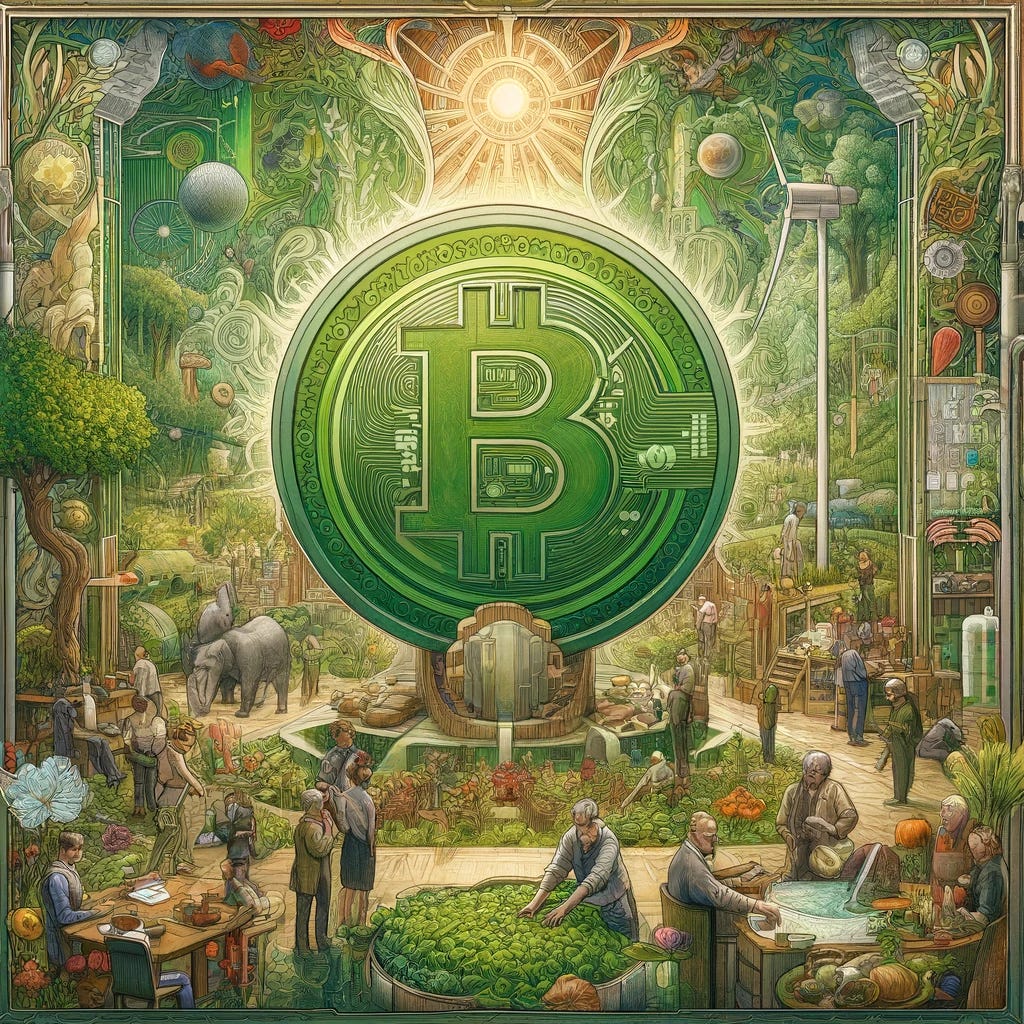This post has the videos and images for web site, in addition to the white paper itself.
Green Coin – Description of Investment – White Paper
by Joseph Mark Haykov
April 10, 2024
Introduction
It is a well-documented fact that some individuals enjoy the thrill of gambling. However, within the realm of retirement investing, a stark contrast emerges: a prevailing aversion to risk. This aversion is rooted in the goal of securing financial independence to avoid the necessity of re-entering the workforce—a prospect deemed intolerable by many, whether due to the psychological burden or the physical limitations associated with old age. Thus, we establish an axiomatic assumption: the intolerability of returning to work for a retiree is a profound motivator, driving a deep-seated aversion to the loss of freedom and autonomy that employment represents. Consequently, the fear of financial losses, which could potentially necessitate a return to the workforce, becomes disproportionately magnified, often overshadowing rational investment decisions.
In practice, the trading of retirement funds by individual investors often aligns with what is referred to as "dumb order flow," primarily due to significant asymmetries in information that favor professional traders on Wall Street. This reality starkly contrasts with the idealized notion of an unfettered, symmetrically informed exchange envisioned by the Arrow-Debreu model. Within this environment of widespread information asymmetry, the market essentially transforms into a zero-sum game, wherein the better-informed consistently gain at the expense of the less informed. Bill Sharpe, the pioneer behind the Capital Asset Pricing Model (CAPM), highlighted this dynamic in his seminal 1991 paper, "The Arithmetic of Active Management." Consequently, individual retirees frequently find themselves as the least informed parties in these transactions, thereby becoming prone to exploitation—a scenario anticipated by, and aligning with, the predictions of the Arrow-Debreu model of mathematical economics.
Despite the apparent simplicity and intuitive nature of this concept, where barring mechanisms for mitigating fraud, the more informed party will always benefit in any voluntary exchange at the cost of the less informed counterpart—as pointed out by George Akerlof in his research on market for "lemons"—it took the broader public decades to recognize this. The tireless advocacy of John Bogle over three decades, promoting index funds as a strategic countermeasure to the pitfalls of asymmetric information, played a pivotal role in this gradual realization.
Nonetheless, a significant challenge remains for many retirees or those nearing retirement: grappling with inadequate funds for a comfortable retirement, often the result of financial setbacks due to poor investment decisions. This situation is particularly dire for those identified as the least informed counterparties. Such circumstances prompt a notable shift in subjective risk perception among those at risk of losing their retiree status. Faced with the bleak prospect of returning to work, a paradox in risk behavior emerges: a marked propensity towards high-risk, high-reward financial gambles, like lottery tickets, despite the slim chances of securing sustainable financial independence through such ventures. This inclination is driven more by the aspiration for a work-free existence than by sound financial planning or investment strategy.
This risk-seeking behavior, as observed by Kahneman and Tversky, challenges traditional economic rationality. Through the development of prospect theory, they demonstrated that investors' decisions often significantly deviate from what is considered 'rational' in classical economics, especially in the face of certain losses. Yet, such behavior is entirely rational within an individual's unique framework of axioms, particularly when considering the axiom that returning to work represents an intolerable loss. Therefore, any risk perceived as potentially averting this dreaded outcome is deemed sensible, illustrating that actions, seemingly irrational at first glance, are in fact perfectly rational and understandable when viewed through the prism of an individual's subjective rationality and foundational beliefs.
In our dialogue, we focus on a distinct segment of investors who have transcended mere comfort in retirement to significantly amplify their wealth. This group diverges sharply from the participants in the "dumb order flow" that certain Wall Street entities exploit. These astute individuals have not only safeguarded their retirement savings but have also substantially increased their holdings, navigating skillfully through the less principled elements of the financial industry. With sharp awareness and a keen ability to navigate the complex web of misinformation, they have avoided the snares set by those who seek profit at the expense of the uninformed.
It is essential to acknowledge that the lavish lifestyles enjoyed by some hedge fund investors inherently rely on the profits extracted from these less informed market participants. This scenario highlights a core principle of market transactions: the zero-sum game, where one's gain is necessarily another's loss. In such a context, the aggregate of profits and losses within the market is fixed, underscoring the critical importance of informed decision-making for those intent on preserving and expanding their wealth.
Armed with significant purchasing power, these informed investors find themselves at a pivotal juncture, in pursuit of investment avenues that offer more than mere preservation of wealth against the backdrop of depreciating fiat currencies or the modest yields of low-risk debt instruments like U.S. Treasury securities. This discussion is directed at you, the investor with a robust financial foundation, seeking wise and lucrative investment opportunities.
Revolutionizing Asset Management and Environmental Sustainability with Green Coin
Dear Investors,
Welcome! We are thrilled to introduce a groundbreaking concept in counterparty risk management through diversification—a once-unattainable feat, now realized by Transparent Network Technologies. If 'counterparty risk diversification' sounds new to you, don't worry. It involves dispersing investment risk across various entities to minimize the fallout from any single party's failure. Our strategy leverages an electronically maintained, peer-to-peer ledger, collectively owned and operated by all investors as a group. This ledger precisely details the allocation of shares of an underlying asset into each shareholder's wallet.
Consider an 8000-acre property in New Hampshire as an example. At the heart of this asset is an easement acquired from the property owner, against which 8000 green coins are issued. These green coins, akin to Bitcoins, can be deposited into any wallet, with each representing a 1/8000th share of the easement and thereby contributing as capital to a 'limited partnership.' The issuance of these 8000 green coins denotes 100% ownership of the underlying asset. Green coin owners may then transfer their coins into buyers' wallets, enabling a broad range of individuals to acquire shares of the easement, recorded in a general ledger.
This asset can be monetized through the sale of carbon credits or by transactions with environmental groups aiming to prevent deforestation. Property easements are extremely valuable and versatile. Organizations like the Sierra Club often purchase these easements at prices exceeding the property's market value. As a green coin owner, you're entitled to all fiat money income from these sales.
It's important to highlight that each green coin owner, acting as a shareholder, also benefits from the sale of carbon credits on the open exchange. This dual income stream emphasizes the multifaceted value of green coins, marking them as both an innovative financial instrument and a contributor to environmental sustainability.
Additionally, there's consistent demand for green coins from the property owner. By repurchasing all green coins and depositing them into a 'dissolution' wallet, the easement can be lifted, restoring the full use value of the property to the owner, be it the original or a subsequent one. Consequently, green coins retain their inherent value.
The intrinsic value of money, such as its utility in real-world applications like constructing a solar farm, is essential. This underlines why green coin represents the truest form of money—acting not only as a medium of exchange but also offering a guaranteed alternative market use-value, always!
But that's just the beginning. Green coin stands out as a perfect store of value, always with an alternative use value, and as an exemplary medium of exchange. Our payment processing system, known for maintaining full information symmetry, can vouch for this. We provide a form of money that is as transferable and secure as Bitcoin, with zero counterparty risk. This is achieved through a payment system where all activities are independently verifiable for honesty, making fraud easily detectable and preventable. Each payment recipient must sign for the incoming payment to be validated in our TNT True – NO – Trust through True Transparency bank system. Enabled by batch processing, this dual-signature functionality ensures constant symmetric information, detailed on our website, tnt.money.
Welcome to green coin, where you can purchase a real asset that is as secure and easy to exchange as Bitcoin, without any counterparty risk. And yes, we process 20,000 transactions per second, cost-free! No mining in TNT. Discover more at tnt.money – you're going to love it!
















